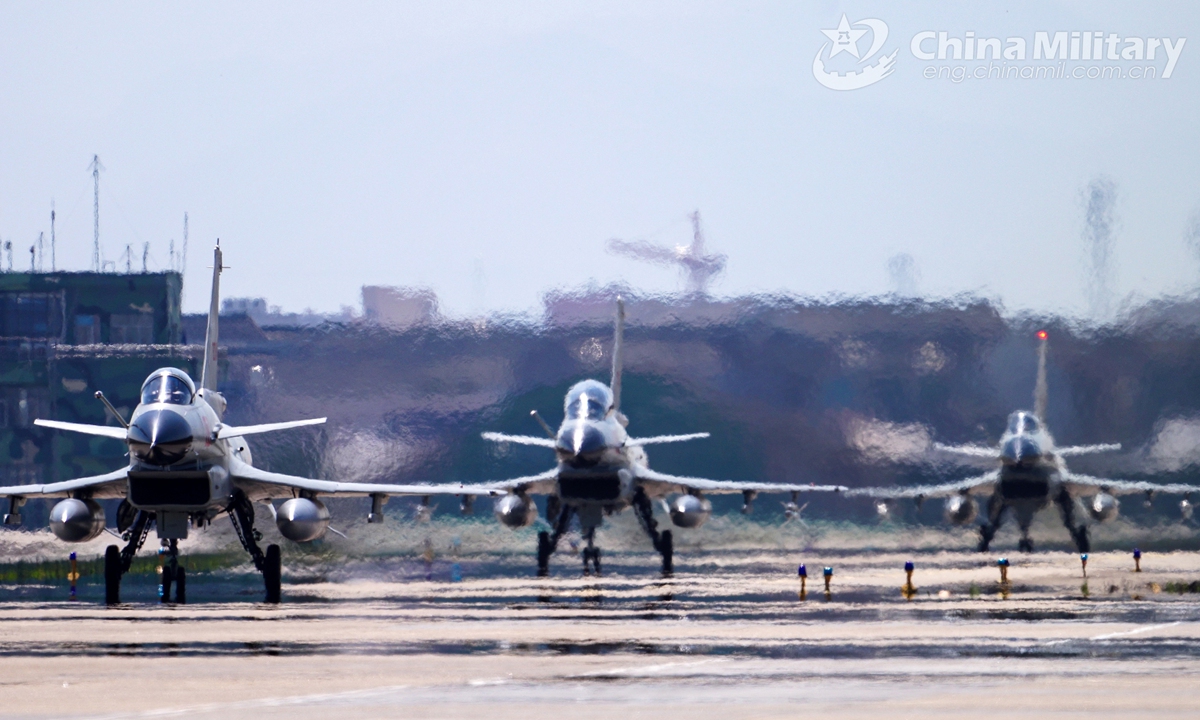Chinese mainland needs adequate countermeasures to new US guidelines over Taiwan: Global Times editorial

J-10 fighter jets attached to a naval aviation brigade under the PLA Eastern Theater Command get ready to take off on February 20, 2021, kicking off their 2021 annual training.Photo:China Military
The US Department of State announced on Friday that it has issued new guidelines for US government interactions with the island of Taiwan. Media reports said that the new guidelines mean that "working-level meetings with Taiwanese officials were now encouraged in federal buildings and could also take place at Taiwan's representative office."
In the announcement, the US Department of State said the new guidelines "encourage US government engagement with Taiwan that reflects our deepening unofficial relationship." It claimed that the new guidelines "provide clarity throughout the Executive Branch on effective implementation of our 'one China' policy, which is guided by the Taiwan Relations Act, the three Joint Communiques, and the Six Assurances."
"The statement spoke only in general terms about the guidelines, which were circulated among government departments but not released to the public," the Voice of America reported on Friday.
According to the public statement and the content that has been revealed, the new guidelines have made some breakthroughs in terms of the "one China" policy. It will allow US officials and those from the island of Taiwan to interact at their official sites, creating new leverage to provoke China. At the same time, the new guidelines have actually taken some steps back from former US secretary of state Mike Pompeo's crazy stance to lift all restrictions. Limits remain on the interactions between the two sides, while "unofficial relations" between the US and the island and "one China" policy were emphasized.
The Biden administration has demonstrated its basic attitude in this regard: It will continue improving ties with the island of Taiwan, meanwhile it will not push the cross-Straits situation to a showdown. These guidelines have given a new push to US maneuvering on the Taiwan question on the basis of strategic ambiguity with a clear direction. Washington has determined to continue playing the "Taiwan card." It is using salami-slicing tactics to pressure the Chinese mainland while trying to hold the evolution of the situation in its own hands.
The Chinese mainland needs to respond appropriately to increase the pressure and risk for the US and Taiwan if they provoke the mainland, and further demonstrate the attitude that they will pay the price for their provocations. Each and every change they make to the status quo should be difficult to achieve rather than easy, and such behavior needs to be warned about rather than encouraged.
What worries the island of Taiwan and the US most is the Chinese mainland's military preparedness. In response to provocations from the US and the island of Taiwan, warplanes of the People's Liberation Army (PLA) have flown around Taiwan and crossed the so-called middle line in the Taiwan Straits, imposing real pressure on the DPP authorities. More voices in the US predict that the PLA will attack the island of Taiwan in the next six to 10 years. Now the US and the island of Taiwan dare not act as recklessly as Pompeo had advocated before he left office, because they are deeply afraid of the possible maximum punishment from the Chinese mainland.
The use of military means to resolve the Taiwan question under extreme circumstances is the Chinese mainland's true ace card. China's military strength has been growing with the continuous increase of the country's comprehensive national power, making China's deterrent more real and credible. In the future, only by using this ace card more effectively can we prevent the island of Taiwan and the US from continuing to take risks, and thus we can firmly grasp the initiative of shaping the cross-Straits situation.
The number and the scale of the mainland's fighter jets that fly around the island of Taiwan and across the so-called middle line of the Taiwan Straits, as well as how close they will approach the island, can be adjusted and increased. In addition, it is believed that the PLA is fully prepared to send fighter aircraft to fly across the island. The move can be carried out at any time amid escalating collusion between the US and the island of Taiwan.
At that time, the DPP authorities and entire Taiwan society will be shocked. The vague US promises to "defend" Taiwan will be hit hard. "Achievements" of their collusion will be wiped out. With the US and the island of Taiwan implementing the new guidelines, the Chinese mainland will initiate its procedures to pile pressure accordingly.
In addition to the military card, the Chinese mainland has diplomatic and economic cards to play. It can bypass Taiwan authorities and directly contact with the people of the island. If the US and the island of Taiwan continue to go further, it should not be difficult for Beijing to win over a few more of Taiwan's "diplomatic allies."
The Chinese mainland is in its prime. Taiwan's share of the Chinese mainland's GDP has fallen from about one-third two decades ago to about one-20th now. The GDP of six provincial-level regions in the Chinese mainland has surpassed that of the island. "Taiwan secession" has long become a joke. Now it is only a question of when and how the Chinese mainland will accomplish the reunification. By latching onto the US, the DPP authorities are quenching their thirst with poison.
